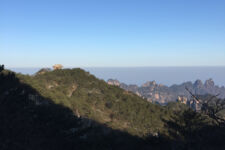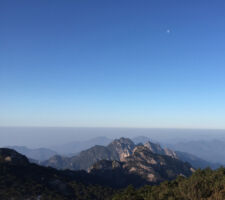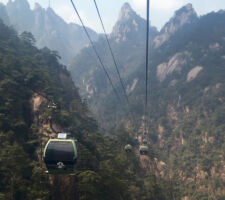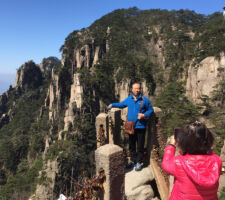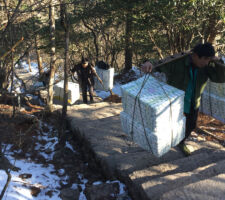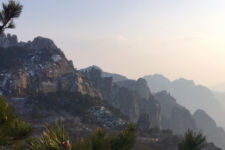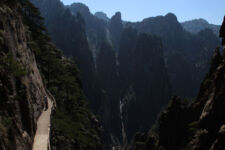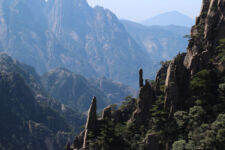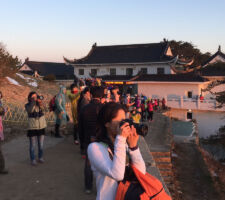Huangshan (Yellow Mountain)
For travelers to China who want to experience the majestic, natural beauty that this country has to offer, add Huangshan (黄山 or Yellow Mountain) to your list of places to visit.
Located in Anhui Province and recognized on the UNESCO World Heritage List, Huangshan is not just one mountain but a granite massif consisting of many peaks, with the tallest at 1800 meters.
Shrouded in mist year-round, these jagged peaks appear like islands among a sea of clouds and have been an everlasting subject of Chinese artwork and paintings.
Scraggly pine tees dotting the mountain range appear to be caught in a strong wind, clinging cliff side in precarious positions. Along with a plethora of native flora, including rhododendrons and mountain laurel, the occasional squirrel will cross your path along the many paved hiking trails.
If you visit in the fall or winter seasons, extremely cold temperatures and ice in most places can limit your time and areas to explore. In other words, proceed with caution and be prepared for possible trail closures due to inclement weather and risk of injury. Summers are typically hot and rainy. Like many places, March-April and September-October are your best chances for good to great weather.
See & Do
Huangshan is about hiking, urban style, with paved paths and many, many stairs going up and down. As a result, wear shoes with good grip and ideally hiking boots.
Join the legions of Chinese and foreign tourists alike in taking photographs along the way, with spectacular vistas and scenic points of interest that can vary in appearance with every change of weather. Just beware of the selfie sticks and tour groups identified with bright yellow or red hats, being shepherded along the narrow paths by a local guide bellowing through megaphones.
With many hiking paths to choose from, the Grand Canyon of West Sea (西海大峡谷徒步) is a must-do for your itinerary. This is doable in a single day, but plan and provision well since the long climb down begins from a starting point about 1.5 km from the Yunggu cable car station. That said, and considering the many more paths to explore with endless up and down steps, I truly appreciated the two nights and two+ days spent on the mountain-top hotel that served as our “base camp.”
In terms of provisions, bottled water, Coca-Cola products, and a few other beverages are sold at the various shops and hotels up high. Best to bring a water bottle with you for the hikes, as you can go an hour or more between places. Food options are limited on the mountain, but hotel restaurants and a few small shops offer snacks and drinks, in addition to the usual tourist items such as postcards and trinkets promoting Huangshan.
Visitor reviews often comment about the relatively high prices, but considering that ALL supplies are carried on the backs of sherpas balancing heavy loads on bamboo rods, it’s a wonder that the hotels and shops have as much inventory as they do. We encountered several of these back-breaking laborers along the paths, making our leisurely hikes seem like a luxury in comparison.
The renowned sunrise and sunset views draw the attention of most visitors to various designated lookout points each day. Proper planning makes all the difference in securing a coveted spot to enjoy the experience.
When good weather and clear skies prevail, nighttime star gazing can also be breathtaking. Assume an overnight stay at a hotel on the mountain to make this possible, and recon some good areas during daylight hours to decide where best to get away from the hotel lights.
The mountain peaks place you above most of the haze, smog, and light pollution, making a sky full view of the stars possible. Combined with the solitude of the area in the evening hours and a good pair of binoculars, this experience can be especially rewarding for those of us urban dwellers who are lucky to spot even a single star in the city night sky.
Where to Stay on Huangshan
Over the years the hotel options on the mountain have expanded and improved, with Xihai Hotel as one that I’d recommend to our foreign friends and family.
A relatively expensive hotel by Chinese standards, Xihai is worth it for the comfortable bedding and warm orange parkas supplied for your sunrise and sunset excursions. You’ll appreciate both after a long day of hiking.
As mentioned in many of the TripAdvisor reviews, the breakfast buffet offers typical Chinese fare, nothing fancy. The a la carte dinner menu had a decent selection of typical Chinese dishes, including a comfort-filling chicken soup and flavorful stir-fried cabbage dish that even our young kids loved. We appreciated the added amenities: spa-like services (the foot massage was a welcome treat after our long hike, but be prepared for a bit of up-selling and suggestion for a tip at the end, especially if you look like a foreigner or wàiguórén) and a sundries shop with brand-name chips and candy bars that likely give it the added distinction as a high-end Chinese hotel.
Two-Night Itinerary
Our family of four traveled from Shanghai to stay on the mountain for two nights during our spring break holiday at the end of March. Thankfully, we experienced beautiful weather and low crowds, making this trip one of the most memorable so far since moving to China nine months before.
Key tip: avoid Huangshan on Chinese national holidays. Just don’t bother. Consider these additional options for your visit.
Day One: Arrival
Plan your arrival based on the the shuttle bus and cable car schedule, which you should review along with pre-loading area maps of Huangshan onto your smartphone. The cable car runs from 07:30-16:30, so I’d suggest catching the 20-minute shuttle bus to the cable car station no later than 15:00.

- Arrive at Tangkouzhen 汤口镇 about 13:00 (we left Shanghai by car around 7:00).
- Lunch in Tangkouzhen is okay but fairly expensive for what you get. We would pack a lunch next time.
- Make your way to shuttle bus station and buy tickets going up to Yungu cableway (see shuttle station map).
- When you get off the bus, walk downhill a little ways and follow signs to Yungu cableway to buy tickets (tourist trinkets and snacks available along the way).
- Once at the top, you can take two paths. Both get you to the hotels, but the longer path is quite scenic.
- We easily followed the signs to Xihai Hotel. Be careful to choose the correct path at each intersection.
After a fairly smooth check-in with basic English-speaking hotel staff, we settled in our rooms and decided to catch the sunset view. While the daylight hours were deceivingly warm, the temperatures fell rapidly along with the sun and made us wish we had dressed warmer. In other words, layer well or bring the hotel room-supplied parkas for the wait at the various viewing spots, where you’ll be competing for a seat on the rocks alongside the camera tripods and other tourists.
Day Two: Hiking and Sightseeing
One of the best sunrise viewing spots is up near the weather observatory at Bai-e-Ling or White Goose Ridge.
Plan ahead which route you will take, and be sure to bring a flash light for the pre-dawn hike. It may take about 45 minutes or more to get up there, so give yourself enough time to take a few breaks along the way. We didn’t, unfortunately, and that hike became our morning stair-climber cardio workout, heightened by the high altitude and immediate affect on our breathing. We arrived to the peak with just seconds to spare before the sun made its appearance on the horizon. Phew!
We returned to the hotel to shed our heavy orange parkas and refuel with the breakfast buffet before venturing out again for a full day of hiking.
Any scenic trail will be great, so get out your map or reference the various strategically positioned signs to pick a path. We started with the entrance to the Grand Canyon of West Sea (西海大峡谷徒步), a 10-15 minute walk from the Xihai hotel. Once we reached the bottom of the valley, the funicular brought us back up high, from where we explored Turtle Peak and Jade Screen area.
Again, Huangshan hiking will involve a lot of stairs. A LOT OF STAIRS. Be prepared mentally and physically, though you can set your own pace as long as the larger red or yellow-hat tourists groups don’t get in your way. My FitBit at the end of this day registered over 26,000 steps, 236 floors, and close to 11 miles. There must be a badge for that.
Day Three: Departure
Satisfied with our Day One sunset and Day Two sunrise and hike, we decided to get down the mountain after breakfast on Day Three. We chose wisely, as the steady streams of day-hike tourists began their arrival at the cable car station as we approached for our descent.
Fitting, one of the final wooden signs we spotted summarized it best: “Leave the scenery in your memory and your virtue in the area.”
